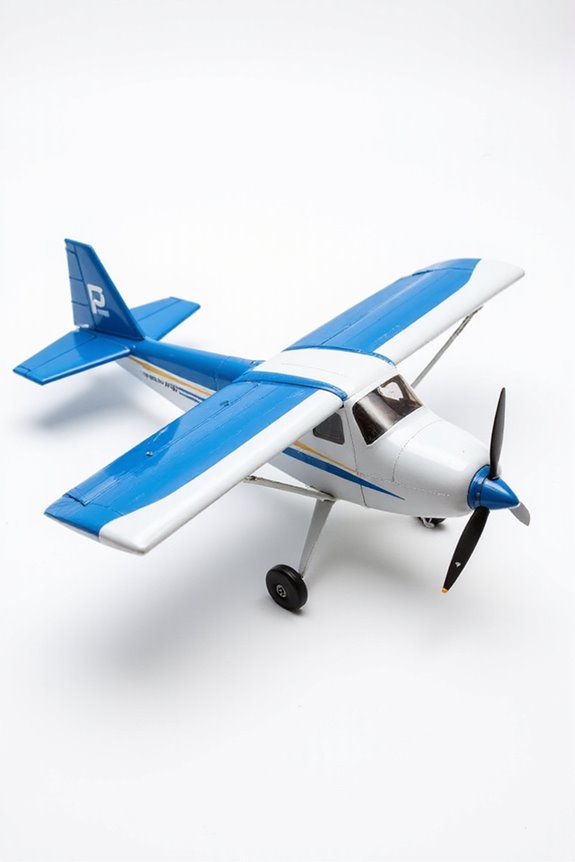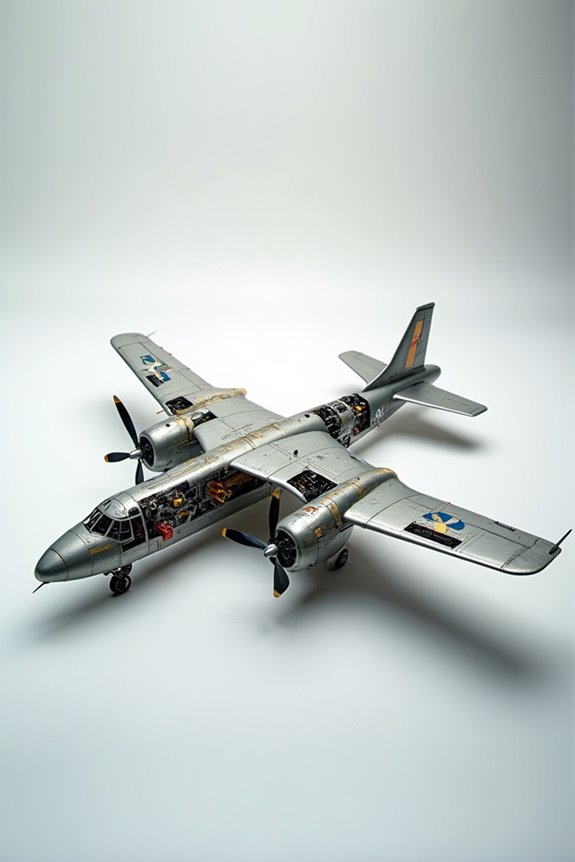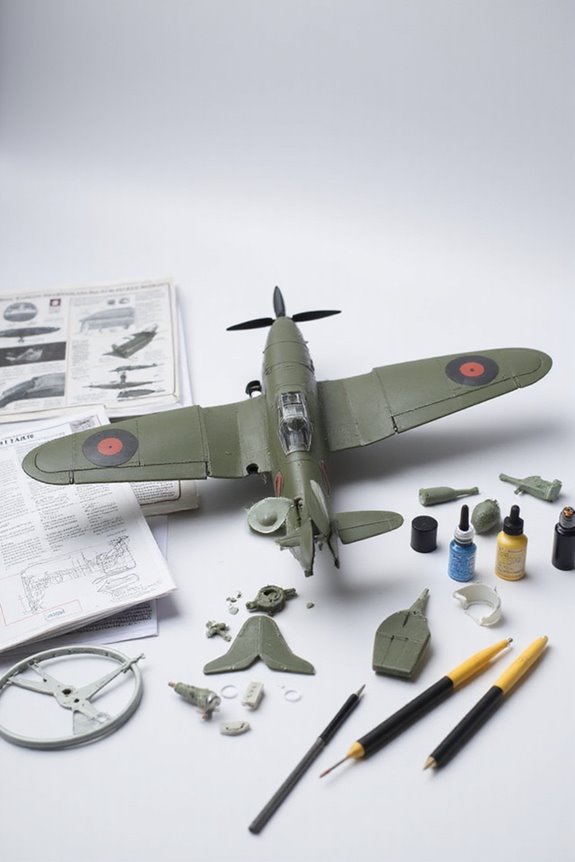If you’re diving into the world of RC planes, we’ve got some great beginner options for you. Planes like the E-flite Apprentice STS are perfect, with their SAFE technology, making them easier to handle. High-wing trainers, such as the Dynam DHC-2 Beaver V2, are stable and durable for rough landings. Plus, many come ready-to-fly with advanced stabilization features. Get ready to soar safely and confidently! There’s plenty more to explore as you choose your perfect first flyer.
Key Takeaways
- Look for beginner-friendly models like the E-flite RC Airplane Apprentice STS that incorporate SAFE technology for enhanced safety and stability.
- High-wing trainer planes provide stability during flight, making them ideal for new pilots; options include the Dynam DHC-2 Beaver V2.
- Choose ready-to-fly (RTF) packages that come pre-assembled, ensuring you have everything needed for immediate flight.
- Opt for models with built-in stabilization systems and adjustable flight modes, facilitating gradual learning as skills improve.
- Consider durability and crash resilience, as new pilots may experience more mishaps during their learning phase.
Understanding RC Planes and Their Features
When we think about RC planes, it’s easy to get excited about all the gadgets and gizmos that make these flying wonders possible. These small aircraft come in various RC plane types, each with unique features that cater to different skill levels.
At the heart of these planes are control surface mechanics. The servos, those tiny motors inside, maneuver the ailerons, rudder, and elevator based on our commands from the transmitter. It’s like having little robots controlling the plane’s movements!
Choosing the right plane is essential for a smooth flight; they often come with electronics that guarantee precise handling. Additionally, many models feature stabilization technology that helps maintain stability during flight. So, whether you’re in it for cruising or acrobatics, they can make our flying dreams come true—just remember to keep it low and avoid the trees!
Recommended Beginner RC Planes With Advanced Flight Assistance
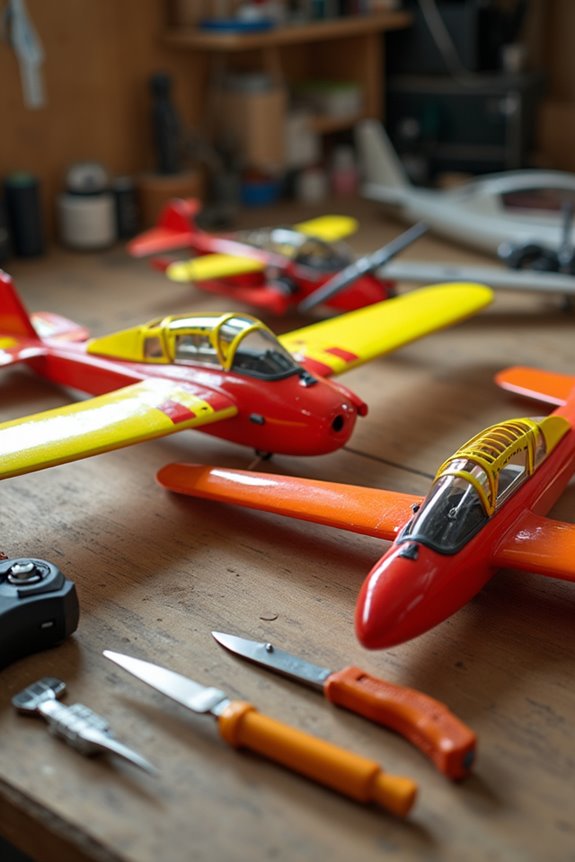
So we’ve explored the exciting features of RC planes, and now it’s time to talk about some fantastic options for beginners who want that extra bit of help in the sky. For example, planes equipped with SAFE technology provide advanced safety by limiting pitch and roll, preventing mishaps that might send us scrambling.
There are beginner modes that auto-coordinate turns, perfect for those just starting out. The panic recovery button is a lifesaver, returning the plane to level flight when things get dicey. Plus, GPS-assisted features offer altitude hold and return-home functions, making our flying experience smoother. With these advanced flight assistance systems, we’re setting ourselves up for success—and a lot less lawn mowing! Additionally, models like the E-flite RC Airplane Apprentice STS are designed for easy handling and provide multiple flight modes to enhance the learning process.
Popular High-Wing Trainer RC Planes for Beginners
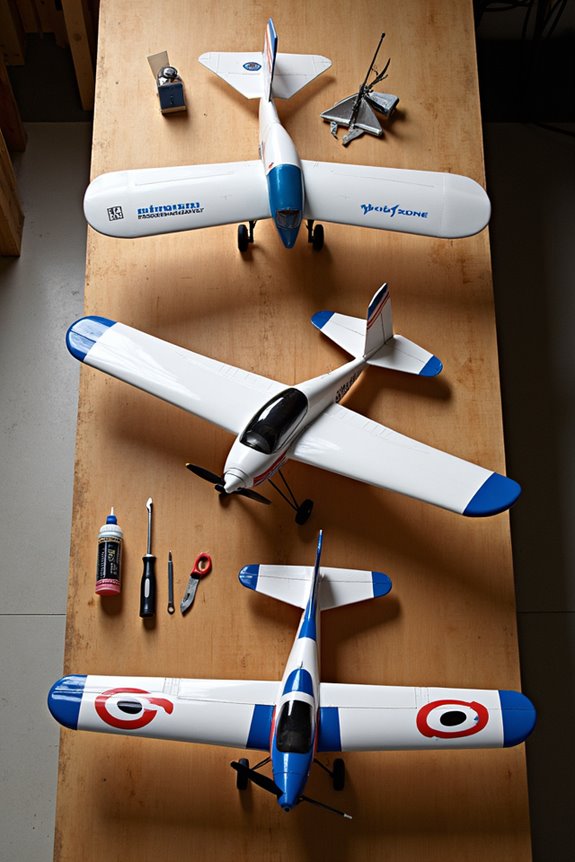
If we’re diving into the world of RC flying, high-wing trainer planes are often the first choice for beginners. These models, like the HobbyZone Sport Cub S2 and Volantex Ranger 757-3, showcase high wing advantages, offering stability benefits that make flying feel more manageable.
With their wings positioned above the fuselage, these planes provide a gentle glide and extra control. The durable foam construction means they can endure a few rough landings—trust us, we’ve all had those!
Models like the Dynam DHC-2 Beaver V2 and Flyzone Sensei FS come equipped with integrated stabilization, pushing the learning curve into overdrive. These planes not only keep us grounded but also help us soar in the skies with confidence! Additionally, choosing models with built-in stabilization systems can significantly enhance control during flights for new pilots.
Beginner-Friendly Electric RC Planes With Ready-To-Fly Packages
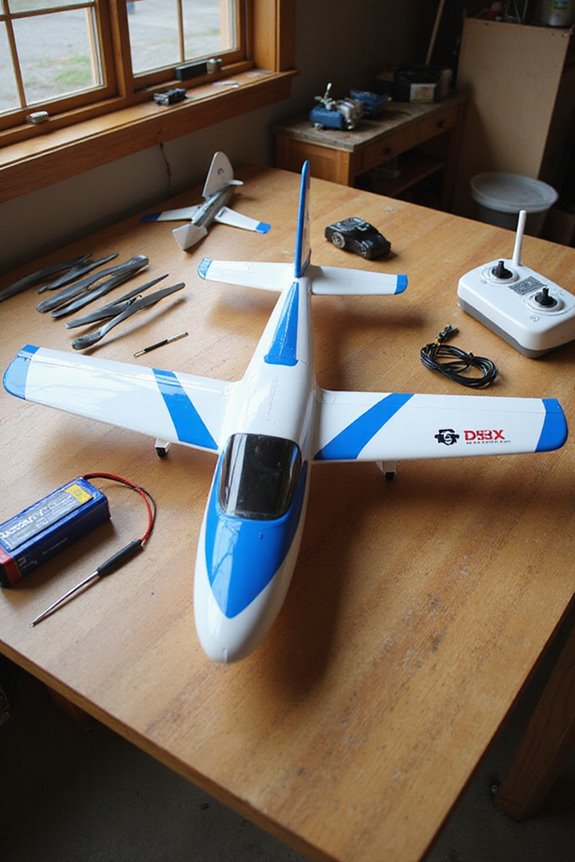
Whether we’re just starting out in the exciting world of RC flying or looking to expand our fleet, beginner-friendly electric RC planes with Ready-To-Fly (RTF) packages are a solid choice. These RTF planes come with everything we need—like the plane, transmitter, battery, and charger—making our first flight just minutes away.
Many models feature stabilization technology, which helps us keep it steady, even if we panic! Plus, they’re often lightweight and durable, giving us a fighting chance against those inevitable crashes.
Some might think RTF planes are low quality, but they can actually match higher-end kits. The real beauty is in the hassle-free entry, saving us time and money while debunking those pesky beginner misconceptions! Additionally, many RTF models come with adjustable flight modes that cater to different skill levels, making them versatile options as we progress in our flying journey.
Scale-Looking Beginner RC Planes With Aesthetic Appeal
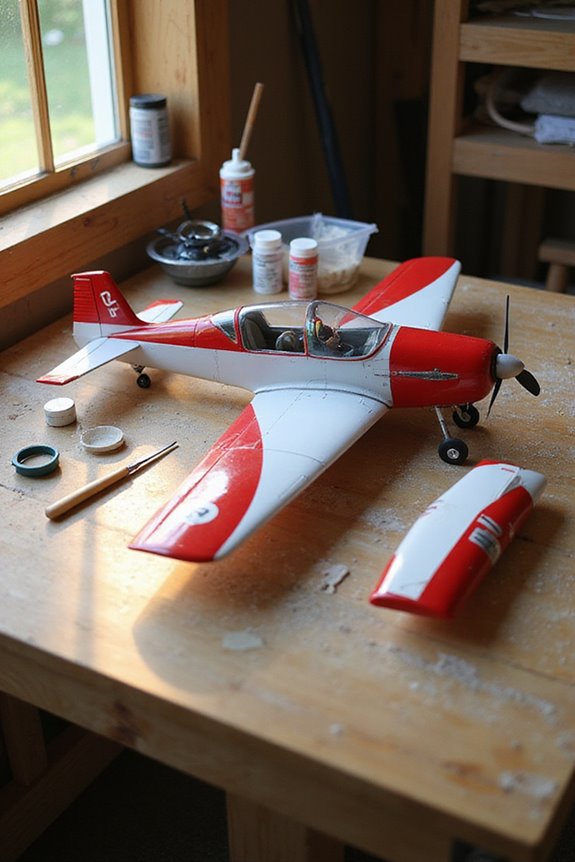
For those of us who appreciate cool designs as much as flying, scale-looking beginner RC planes deliver both style and substance. Take the FMS Ranger 1220mm, for instance. It resembles a high-wing Cessna 152 and is a stable flyer, perfect for new pilots. Plus, it comes in multiple colors—who doesn’t love variety?
Then there’s the Dynam DHC-2 Beaver V2 Bigfoot STOL. With its rugged EPO foam and functional flaps, it’s built to conquer rough landings while still prioritizing scale fidelity.
The HobbyZone Sport Cub S2 even brings classic cub aesthetics into play. With beginner aesthetics like SAFE technology, it’s easy to appreciate how looks can match flying performance. We can have our cake and eat it too! Additionally, these models often include flight mode options that cater to different skill levels, enhancing the learning experience for new pilots.
Key Features to Consider in Beginner RC Plane Selection
When diving into the world of RC planes, it’s easy to feel overwhelmed by the choices out there. We should start by considering the plane specifications. Size matters! Larger trainer models provide flight stability since they handle wind better and aren’t too large to manage.
Next, let’s think durability and repairability. Planes made from firm foam absorb crashes well—trust us, they’ll need it!
A good power system is crucial, too. For beginners, brushless motors with a KV rating of 850KV to 1500KV offer manageable speed. Additionally, many beginner models come equipped with built-in stabilization systems to assist novice pilots in learning to fly effectively.
Finally, RTF kits are lifesavers, as they come assembled, keeping the tech headaches at bay. Remember, the right selection makes all the difference in our flying adventures!
Benefits of High-Wing Trainer Designs for New Pilots
High-wing trainer designs really shine when it comes to flying—a bit like having a friendly guide at your side on your flying journey. The high wing advantages include incredible beginner stability, thanks to the wing position above the fuselage. This setup keeps the weight below the wing, helping the plane self-correct like a seasoned pro.
Plus, that dihedral angle resists rolling, making those early flights feel smoother and less nerve-wracking. With predictable flight patterns and larger wing areas, these planes are a joy to maneuver, building our confidence without added stress. And let’s not forget, they tend to be more durable for those inevitable learning mishaps. So, why not kickstart our flying adventures with a trusty high-wing trainer?
Tips for Flying Your First RC Plane
Flying an RC plane for the first time can feel a bit like trying to ride a bike uphill—challenging at first, but totally rewarding once we get the hang of it! Before we take off, let’s not forget our pre-flight checklist. Checking all control surfaces and ensuring they’re moving correctly can save us a lot of headaches.
As we practice our flight skills, we should set clear goals with each session. Focus on maintaining altitude and performing smooth turns. Remember, gradual input is key—sudden movements can send us into a nosedive!
Finally, don’t skip out on learning to land. Glide in with gentle throttle adjustments, and with practice, we’ll land gracefully like seasoned pros. Happy flying!
Maintenance and Care for Beginner RC Planes
Maintaining our RC planes is just as important as flying them, and trust me, a little care goes a long way! First, we should follow a maintenance checklist. This includes checking control surfaces for smooth movement and inspecting the propeller for cracks.
We also need to prioritize battery safety. Always charge to manufacturer specifications and check batteries for swelling or heat. A safe battery is a happy battery!
After flying, let’s give our planes a gentle clean with compressed air and a microfiber cloth. This prevents corrosion and keeps those motors happy. Finally, store them in a climate-controlled space, away from direct sunshine. With a little TLC, we can guarantee our planes are ready to soar whenever we are!
Frequently Asked Questions
What Is the Average Flight Time for Beginner RC Planes?
When it comes to flight duration, beginner RC planes typically offer 5 to 15 minutes of battery life. By optimizing our flying techniques and battery usage, we can potentially extend that time to 25 minutes.
Can I Fly RC Planes Indoors?
Absolutely, we can fly RC planes indoors. However, we need to take into account space requirements carefully, ensuring there’s enough room to navigate safely. Lightweight models and stabilization technologies make indoor flying enjoyable and manageable for us.
How Do Weather Conditions Affect RC Plane Performance?
Imagine our RC plane soaring gracefully, but then wind effects whip it around like a leaf. Temperature impacts its performance too; let’s be mindful of these elements for a smoother flight and safer adventure together.
What Should I Do if My RC Plane Crashes?
If our RC plane crashes, we should prioritize crash recovery. Let’s assess the situation, avoid turning off the radio, and consider repair tips like swapping landing gear to minimize costs and keep flying safely.
Are There Age Restrictions for Flying RC Planes?
Did you know that 70% of RC pilots start flying at 14 or older? We should follow safety guidelines, check age requirements from manufacturers, and always guarantee younger pilots are supervised for a safe experience.

